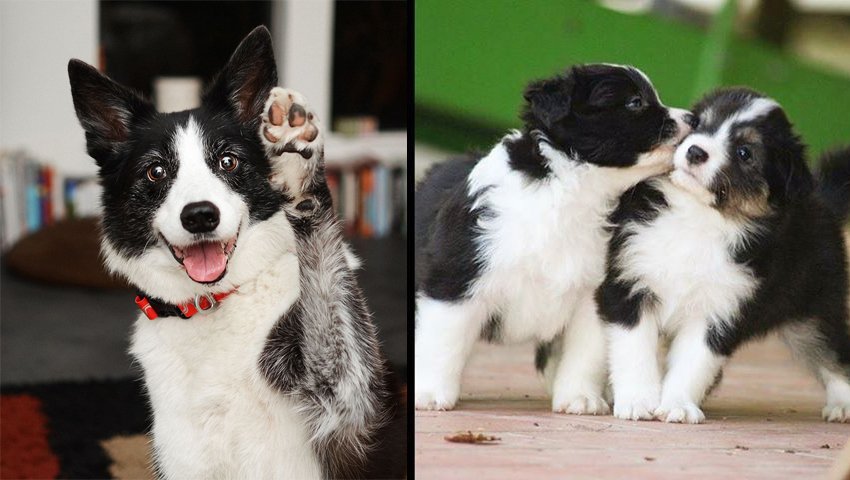Have you ever wondered what your Border Collie is trying to tell you with their behavior? Well, you’re in luck because today we’re going to talk about the language of Border Collies and how to understand their signals. If you’re a proud owner of a Border Collie or thinking of getting one, knowing how to communicate with them is key to a happy and well-behaved canine companion!
Border Collies are incredibly intelligent dogs, and they have a unique way of expressing themselves. Understanding their signals can help you bond with your furry friend and address their needs effectively. For example, when your Border Collie starts nipping at your heels or barking excessively, it might not just be random behavior but a way of telling you they need more mental or physical stimulation. Learning to interpret their signals can prevent misunderstandings and help you meet their needs in a way that makes both of you happy.
In our article, we’ll delve deeper into the various signals that Border Collies use to communicate, from body language to vocalizations. You’ll discover how to read the subtle cues in their tail wagging, eye contact, and stance. We’ll also explore the meanings behind their different barks and how they use their ears and lips to express themselves. Understanding your Border Collie’s signals will not only strengthen your bond but also improve their overall well-being. So, stay tuned and get ready to become fluent in the language of Border Collies! Have you ever wondered what your Border Collie is trying to tell you? As dog owners, it’s important for us to understand and interpret the signals that our furry friends are sending us. Border Collies, in particular, have a unique language of their own, with various body language cues, vocalizations, and tail positions that can provide valuable insight into their thoughts and emotions. In this article, we will delve into the fascinating world of Border Collie signals, helping you to better understand and communicate with your beloved pup.

Recognizing Body Language
When it comes to understanding our Border Collies, reading their body language is key. By recognizing certain cues and movements, we can gain valuable insight into their emotional state and intentions. Here are some important aspects to consider when interpreting your Border Collie’s body language:
Reading Facial Expressions
The face is often referred to as the window to the soul, and this holds true for our furry companions as well. By paying attention to your Border Collie’s facial expressions, you can gain valuable insight into their current mood. Look for signs of relaxation, such as soft eyes and a relaxed jaw, which indicate contentment. Conversely, signs of tension, such as a tight jaw or furrowed brow, may indicate stress or anxiety.
Observing Ear Movements
The position and movement of your Border Collie’s ears can provide valuable clues about their level of arousal and focus. Ears held forward and upright typically indicate attentiveness and interest, while ears flattened against the head may indicate fear or submission. Pay close attention to your Border Collie’s ears to decipher their emotional state and intentions.
Noticing Eye Contact
Eye contact is an important form of communication among dogs, and understanding its meaning can help us better understand our Border Collies. Direct eye contact may indicate confidence or assertiveness, while prolonged, intense eye contact may be a sign of aggression. On the other hand, averting their gaze or avoiding eye contact may indicate fear or submission.
Analyzing Body Posture
The overall posture of your Border Collie can provide valuable insights into their emotional state and intentions. A relaxed body posture with loose muscles typically indicates contentment, while a stiff and upright posture may indicate aggression or fear. Pay attention to your Border Collie’s body positioning to better understand their signals and respond accordingly.
Interpreting Vocalizations
In addition to body language, vocalizations are another important aspect of understanding Border Collie signals. While Border Collies are not known for excessive barking, their vocalizations can still provide valuable information about their needs and emotions. Here are some common vocalizations and their possible meanings:
Decoding Barking
Barking is a common form of communication among dogs, and Border Collies are no exception. However, it’s important to differentiate between different types of barks to understand their intended message. A short, sharp bark may indicate alertness or warning, while a repetitive, high-pitched bark may indicate excitement or frustration. Understanding the context and accompanying body language can help you interpret your Border Collie’s barks more accurately.
Understanding Whining
Whining is often associated with feelings of anxiety, discomfort, or attention-seeking behavior. If your Border Collie is whining, it’s important to assess their environment and physical well-being to address any underlying issues. Whining can also be a sign of excitement or anticipation, especially during playtime or when anticipating a reward.
Analyzing Growling
Growling is a vocalization that is often associated with aggression or warning. If your Border Collie growls, it’s important to pay attention to the context and accompanying body language to determine the underlying cause. Growling can be a sign of fear, territoriality, or discomfort, and should be addressed promptly and appropriately.
Interpreting Howling
While Border Collies are not known for excessive howling, it can still occur in certain situations. Howling can be a form of communication, particularly when your Border Collie is trying to vocalize their needs or alert you to something. Pay attention to the context and accompanying body language to better understand the message behind your Border Collie’s howls.

Understanding Tail Positions
One of the most visually striking aspects of a Border Collie’s body language is their tail. The position and movement of their tail can provide valuable insights into their emotional state and intentions. Here are some key tail positions to be aware of:
Identifying Tail Wagging
Contrary to popular belief, tail wagging doesn’t always indicate happiness or friendliness in a Border Collie. The speed, direction, and height of the tail wag can provide valuable clues about their emotional state. A slow and loose tail wag typically indicates contentment, while a fast and stiff wag may indicate excitement or arousal. Pay attention to the context and accompanying body language to accurately interpret your Border Collie’s tail wagging.
Analyzing Tail Tucking
If your Border Collie tucks their tail between their legs, it’s usually a sign of fear, submission, or anxiety. This is their way of protecting their vulnerable rear end and indicating their lack of confidence in the situation. If you notice your Border Collie tucking their tail, it’s important to assess the environment and address any potential stressors or triggers.
Noticing Stiff or Raised Tail
A stiff or raised tail in a Border Collie can indicate alertness, arousal, or assertiveness. A high, rigid tail is often accompanied by other signs of heightened arousal, such as an upright posture and direct eye contact. This tail position may be seen when your Border Collie is focused on a task or alert to potential threats.

Common Signals in Border Collies
Now that we’ve explored the different aspects of Border Collie signals, let’s dive deeper into some common signals that you may encounter while interacting with your four-legged friend:
Signs of Contentment
When your Border Collie is content, you will notice a relaxed body language and a general sense of calm. Look for signs such as a relaxed body posture, soft and relaxed facial muscles, slow and loose tail wags, and ears held in a neutral position. These signals indicate that your Border Collie feels comfortable and at ease in their environment.
Indicators of Fear or Anxiety
Fear or anxiety can manifest in various ways in Border Collies. Look for signs such as a cowering or shrinking posture, avoidance of eye contact, tail tucked between legs, and whining or panting. These signals indicate that your Border Collie is feeling stressed or uncomfortable and may need reassurance or removal from the triggering situation.
Signals of Aggression
While Border Collies are generally known for their friendly and gentle nature, they are still capable of displaying aggressive behavior if provoked or threatened. Signs of aggression may include a stiff and raised body posture, direct eye contact, growling or snarling, and showing teeth. It’s important to address these signals promptly and seek professional help if necessary.
Expressions of Playfulness
Border Collies are highly energetic and intelligent dogs, and playfulness is often a big part of their personality. Signs of playfulness may include bounding movements, a play bow (front end lowered with hind end raised), a bouncing tail wag, and playful barking. These signals indicate that your Border Collie is in a playful mood and ready for some fun interaction.

Training Border Collies to Respond to Signals
Understanding your Border Collie’s signals is not only beneficial for communication but also plays a crucial role in training. By utilizing positive reinforcement and understanding your Border Collie’s individual preferences, you can effectively train them to respond to signals. Here are some key training strategies to consider:
Using Positive Reinforcement
Positive reinforcement is a highly effective training method that involves rewarding your Border Collie for desired behaviors. This can be done through treats, praise, or playtime. By associating the desired behavior with a positive outcome, you are encouraging your Border Collie to repeat the behavior in the future.
Consistency and Repetition
Consistency and repetition are key in training any dog breed, including Border Collies. Establish clear signals and commands, and be consistent in your expectations and responses. Repeat training sessions regularly to reinforce the desired behaviors and maintain a routine that your Border Collie can rely on.
Reward-Based Methods
Reward-based training methods are an excellent way to motivate your Border Collie and encourage them to respond to signals. This can involve using treats, toys, or praise as rewards for correct responses. Be sure to use high-value rewards that your Border Collie finds particularly motivating to maximize training success.
Understanding Individual Preferences
Every Border Collie is unique, and understanding their individual preferences and motivations can greatly enhance your training efforts. Some Border Collies may be highly food motivated, while others may respond better to playtime or praise. Tailor your training approach to suit your Border Collie’s preferences for optimal results.

Conclusion
Understanding the language of Border Collies is a journey that can greatly strengthen the bond between you and your furry friend. By paying close attention to their body language, vocalizations, and tail positions, you can gain valuable insights into their thoughts, emotions, and intentions. Through training techniques that incorporate positive reinforcement, consistency, and an understanding of your Border Collie’s individual preferences, you can effectively communicate and build a trusting relationship. Embrace the unique language of Border Collies, and watch as your connection with your beloved pup thrives.
